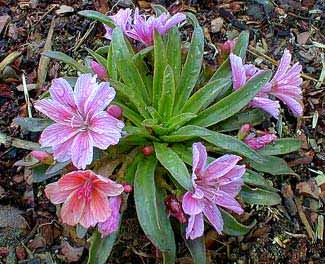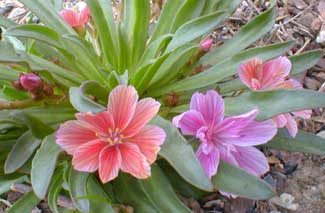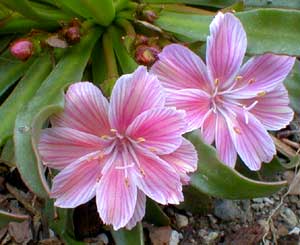 'Little Plum'
'Little Plum'
Long-petalled Lewisia
"The flowers have their angels."
-Christopher Smart
(1722-1771)
(1722-1771)
We have two specimens of this hybrid Cliff Maids (Lewisia longipetala x cotyledon) which bears the cultivar name 'Little Plum.' It has bright rose-pink to red flowers starting in April & lasting at least to June. Some of the blossoms, when they first open, are a pastel orange, so that on some days one sees two or even three distinct bloom colorations mixed together on a single plant.
Most cross-species lewisia hybrids are sterile, but 'Little Plum' produces fertile seed. They grow fairly true from seed, & will have magnificent blooms their second year, even with the rosette of leaves still quite small. I say "grow fairly true" because in fact the colors do vary from plant to plant, even if less so than among sundry other strains which when seed-grown cannot easily be categorized by leaf-shape or flower-color because variations are too broad.
 The species L. longipetala or Truckee Bitterrot is a native of the Sierra Nevada Mountains, found in a very restricted region from western Truckee to Desolate Wilderness. It grows in mesic rocky habitats at the late-season snowlines on ridgetops where sun is best.
The species L. longipetala or Truckee Bitterrot is a native of the Sierra Nevada Mountains, found in a very restricted region from western Truckee to Desolate Wilderness. It grows in mesic rocky habitats at the late-season snowlines on ridgetops where sun is best.The wild species L. longipetala was first gathered in 1875 by John Gill Lemmon (1832-1908), an amateur botanist from Michigan, & a Civil War veteran who had come west after the war. He & his wife Sara Allen Plummer Lemmon adventured along the Pacific coast investigating & writing about plantlife. Mount Lemmon in the Coronado National Park is named for Sarah Ann, the first white woman to attain its summit.
The species was so localized south of Truckee in the Sierra Nevadas that the location of L. longipetala was long lost, until it was not rediscovered in 1967, when Dr. G. Ledyard Stebbin (1906-2000) stumbled upon colonies in the Crystal Range. Dr. Stebbins, a leading evolutionary biologist, was an activist & president (1966-1977) in the California Native Plants Society. He authored among other books Flowering Plants: Evolution above the Species Level (1974).
But during the long period between Lemmon's discovery & Stebbin's rediscovery of L. logipetala, a specimen inexplicably turned up in Royal Horticultural Society Garden near Wisley, misidentified as L. pygmaea. Its uniqueness was noted immediately when it bloomed in 1934, but no one remembered where it had come from.
B. LeRoy Davidson in his wonderful monograph Lewisias (Portland, Oregon: Timber Press, 2000) speculates that it was sent to the Society by expatriate Entglishwoman Ellen Lester Rowntree (1878-1979), who had left her family to live independently, insist on being addressed as Lester, & travelled throughout Californian hinterlands hunting rare plants between 1931 & 1945, & authored Hardy Californians (1936) about landscaping with California native plants. Later in her life she lamented that she had taken her doctor's advice to stay out of the mountains for the sake of her health, saying she would rather have died young in those beloved high hills than become burdensome in great old age. The Lester Rowntree Native Plant Garden still exists on Hutton Road at Flanders Mansion in Carmel-by-the-Sea.
Its populations are in decline & already on the watchlist of plants apt to end up among endangered species, losing its habitat to recreation trail & ski resort development & activity, a general popularity of the Truckee area for tourists, & illegal collecting.
 The cultivated 'Little Plum' was discovered by Jack Drakes' Inshriach Alpine Nursery of Inverness-shire, Scotland, as a random garden hybrid. Seeds were obtained by the German seed merchant Jelitto & that company's field trials showed that 'Little Plum' can withstand conditions that might cause a pure-blooded L. longipetala to be fussy for want of sharper drainage.
The cultivated 'Little Plum' was discovered by Jack Drakes' Inshriach Alpine Nursery of Inverness-shire, Scotland, as a random garden hybrid. Seeds were obtained by the German seed merchant Jelitto & that company's field trials showed that 'Little Plum' can withstand conditions that might cause a pure-blooded L. longipetala to be fussy for want of sharper drainage.Field tests at Michigan State University gave it deservedly high ratings for flowery display, & reported that it made it through a wet winter without the affliction of rot. But alas in spring it proved to be a favorite food of voles, who ate every specimen. Happily, we don't have voles around here!
Released in the year 2000, it was an instant hit in the marketplace, thanks to its physical beauty & for having a more forgiving nature when it comes to imperfect garden conditions. Still, radical drainage should be provided for it, as for any lewisia.
It is noted for especially large flowers compared to the majority of lewisias, having a pleasant musky odor lacking in other species. They bloom April through June most reliably, with reblooms very likely, as late as September. The flowers are close to the leaf-rosette on short scapes, lacking the really tall panicles of L. cotyledon. The tough semi-succulent leaves are long & blade-shaped.
Lewisia tweedyi